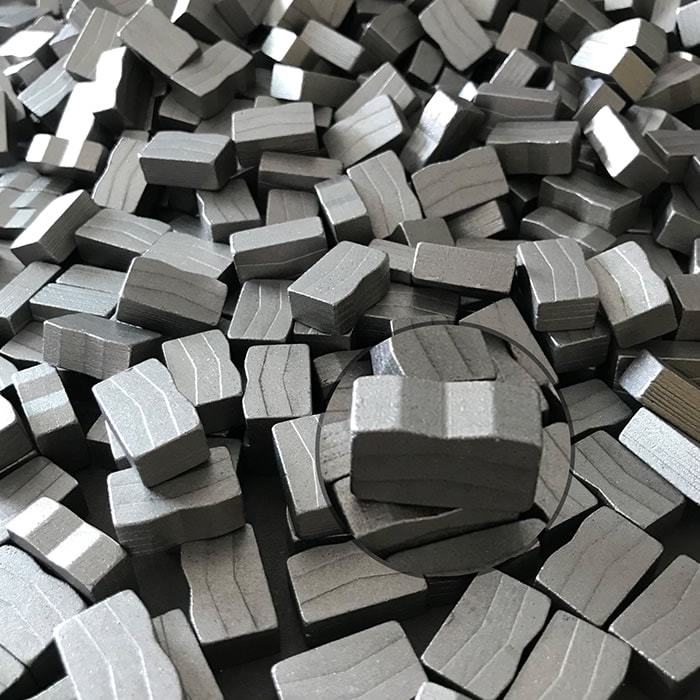7 Steps of Manufacturing Metal Bond Concrete Grinding Diamond Tooling
For the manufacturing of metal-bonded concrete floor grinding tools, there are essentially seven main steps depicted in the accompanying diagram. The diagram features orange boxes that signify these seven pivotal steps, while the blue boxes delineate the stages involved in creating the grinding segments.

It's important to note that the diagram exclusively focuses on the steps related to grinding segment production, as the fabrication of the steel base is typically outsourced by most manufacturers of floor grinding tools.
Upon scrutinizing the diagram, it becomes evident that the production of a concrete floor grinding tool generally encompasses around 7 + 8 = 15 steps. Whether you are manufacturing a single floor grinding tool or a bulk quantity, the requisite steps remain consistent.
Consequently, even for smaller quantities of floor grinding tools, a certain production time is unavoidable. Typically, reputable Chinese suppliers and Axcrete can fulfill general orders within approximately 7-14 days.
Understanding the Tool Production Process: Why is it Important?
For many users, comprehending the intricacies of the production process may not seem particularly crucial. As long as the tools are effective, reasonably priced, and delivered punctually, these aspects are deemed sufficient. However:
a. Having an understanding of the tool production process empowers you to discern critical aspects related to concrete grinding tools and aids in making informed choices during tool selection.
b. An additional advantage is that this knowledge provides insights into common issues that may arise during tool usage, helping users identify which production stages are often responsible for these challenges.
c. Lastly, in instances where customized tools are required, familiarity with the production process proves immensely helpful. It enables you to pinpoint stages that can be tailored to meet your specific needs and enhances communication efficiency with us.
While acknowledging that one objective of this article is to optimize our website and attract traffic, the primary focus is on delivering the three aforementioned benefits. Now, let's delve into a detailed breakdown of each of these processes.
1. Production of Grinding Segments
Let's begin by delving into the production of grinding segments, the integral working components that significantly influence the overall quality of the concrete floor grinding tool. The efficacy of grinding segments is pivotal in achieving the desired grinding results.
1.1 Powder Preparation
Diamond segments come into existence through the meticulous treatment of diamond particles and various metal powders, also known as bonds, under high temperatures and pressure.
Diamond Particles

The size of diamond particles, measured in diamond grit size, plays a crucial role in determining the grinding level. Smaller diamond grit sizes indicate larger diamond particles. In the context of concrete grinding segments, larger diamond particles are more aggressive, making them well-suited for coarse grinding and, in some instances, for removing thinner floor coatings.
Bond (Metal Powders)

The metal bond incorporates diverse metal elements such as iron, tungsten, molybdenum, chromium, nickel, and cobalt. These elements serve various functions in the blade, with a primary role being to secure the diamond particles and gradually wear away during grinding. This wear process exposes the diamond particles, completing the floor grinding cycle.
Ensuring continuous wear necessitates the use of a bond that aligns with the hardness of different concrete types. For example, hard concrete demands a soft bond. Companies may adopt varying standards for bond types; some simplify the selection to three types (Hard, Medium, and Soft), while others, like Axcrete, employ a more precise differentiation with five standards (Very Hard Bond, Hard Bond, Medium Bond, Soft Bond, Very Soft Bond) to enhance concrete grinding efficiency.
Potential Issues and Causes
1. Concrete grinding tools may encounter challenges in proper grinding, resulting in slipping. This issue arises when the bond and the concrete are incompatible. Inadequate wear of the bond during grinding prevents proper exposure of diamond particles, leading to slipping.
2. Concrete grinding segments might experience burning. This occurrence may be attributed to an unreasonable bond composition, rendering the segment incapable of withstanding the high temperatures generated during the grinding process, ultimately leading to burning.
1.2 Mixing of Powders

The powder mixing phase involves the meticulous blending of diamond particles and metal powders using a mixing machine, preparing them for the subsequent step of cold pressing. Typically, this blending process must persist for a minimum of 2 hours or more, representing a factor that constrains the speed of segment production.
Potential Issues and Causes
Unusual scratches may manifest on high-grit concrete grinding segments, potentially stemming from the inadvertent inclusion of lower-grit diamond particles during the mixing process.
1.3 Cold Pressing

Cold pressing entails utilizing an appropriate mold to introduce the previously blended powders into a cold press machine, where the powders take on a solid form under a specified level of pressure.
1.4 Molding
Following the completion of hot pressing and subsequent cooling of the mold, the demolding stage ensues. This step involves unlocking the iron frame and extracting the solid segments formed through hot pressing. At this juncture, the segments may exhibit some rough edges, necessitating additional sandblasting treatment.
1.5 Hot Pressing

Hot pressing involves placing the iron frame from the prior step into a hot press machine, configuring specific pressure and temperature settings. This process facilitates a chemical reaction in the cold-pressed and molded segment under elevated temperature and pressure for a designated duration. The outcome is the creation of a solid segment with a specific diamond density.
Critical factors in this phase encompass parameters such as temperature, pressure, and the duration of hot pressing.
1.6 Removal of Mold and Finalization
Upon the completion of hot pressing and subsequent cooling of the mold, the next phase involves demolding. This crucial step entails unlocking the iron frame and extracting the solid segments formed through hot pressing. It is worth noting that, at this stage, segments may exhibit rough edges, prompting the need for additional sandblasting treatment.
1.7 Sandblasting
Sandblasting constitutes the process of placing the segments into a specialized machine designed for sandblasting. This procedure is employed to eliminate surface roughness, ensuring the segments are appropriately prepared for subsequent welding.
1.8 Inspection of Segments
Segment inspection is a meticulous screening process aimed at identifying segments that do not meet established standards. This inspection typically encompasses three key aspects: appearance, dimensions, and weight.
2. Production of Steel Base
The steel base plays a pivotal role in supporting the segments and facilitating their connection to the grinding machine. For the production of the steel base in floor grinding tools, manufacturers commonly opt for external processing due to its cost-effectiveness. While delving into this aspect is beyond the scope here, two critical points merit introduction:
a) **Customizability of Steel Base:** Given the diverse types of floor grinding machines globally, steel bases often vary. In instances where a manufacturer has not produced the steel base for a specific grinding tool, customization becomes necessary. Axcrete, in the past, has undertaken the customization of various steel bases to align with the unique requirements of different clients and their machines.
b) **Importance of Dimensions:** The dimensions of the matrix, including mounting holes, are paramount. These dimensions determine whether the tool can be properly installed on the grinding machine. Inaccuracies in steel base dimensions can result in tools either not fitting onto the machine or being loosely attached.
Potential Issues and Causes
Inaccurate steel base dimensions can lead to tools either not fitting onto the machine or being inadequately secured. For mainstream concrete grinding tools, Axcrete adopts the original holder plate as a template for production, ensuring precise dimensions. Examples include HTC, Lavina, Husqvarna, and others. This precision guarantees a secure fit on the grinding machine, alleviating concerns about compatibility.
3. Welding of Segments
High-frequency welding, also known as copper brazing, is a commonly employed method for metal bond concrete grinding tools, and it involves manual work.
Potential Issues and Causes
a) **Imprecise Positioning:** Manual welding, reliant on human judgment for segment positioning, may result in inaccuracies. Comparisons between the positions of segments on two concrete grinding tools may reveal significant differences. While this discrepancy may not impact tool performance significantly, it can affect the tool's appearance, a concern more relevant to resellers.
b) **Segment Dropping:** Although rare, segment dropping due to inadequate welding may occur. The floor grinding process does not demand an exceptionally high level of welding strength. Instances of segment detachment often occur when the concrete grinding tool collides with other hard objects during grinding. The potential shift to laser welding in the future offers automation, improved production efficiency, robotic operation, and uniform welding positions, thereby enhancing welding strength and reducing segment detachment occurrences.
4. Sharpening of Segments
Segment sharpening involves using a grinding tool to grind the segments, exposing the diamonds. The direction of sharpening must align with the rotation direction of the concrete grinding tool, ensuring readiness for use.
Potential Issues and Causes
a) **Incorrect Sharpening Direction:** Although not a major issue as the grinding machine can automatically adjust the sharpening direction during operation, maintaining a consistent direction is preferable.
b) **Excessive or Insufficient Sharpening:** Rare occurrences of segments being sharpened too deeply or too shallow have minimal impact on normal usage.
5. Painting

Painting on floor grinding tools serves two primary purposes:
a) **Distinguishing Bonds:** Different bonds are distinguished by utilizing different colors, enabling quick identification of the bond type. For example, black may represent "Medium Bond," and yellow may indicate "Soft."
b) **Brand Differentiation:** Establishing product differentiation for brand distributors.
Potential Issues and Causes
Color variations due to customization may result in slight differences between the desired paint color and the actual color. It's crucial to note that paint color can influence subsequent laser engraving, with certain colors, such as red, requiring multiple passes for clear visibility.
6. Engraving of Logo & Information
The primary method employed for engraving metal bond floor grinding tools is laser marking. The engraving typically includes the brand's logo, diamond grit size, bond type, and, for PCD-type tools, the rotation direction of the tool. This engraving is applied on the steel base, specifically on the side of the segments. The specific location is determined by the available engraving space.
Laser engraving is a crucial aspect of customization, especially for brand distributors seeking to promote their logos on the tools. For end-users like concrete grinding contractors, our own brand name, "Axcrete," is typically marked to enhance brand visibility.
7. Packaging

To ensure the safe transportation of floor grinding tools, each individual tool needs to be separated within the packaging to prevent collisions and potential damage. Therefore, pearl cotton is used inside the packaging box to isolate each tool.
The minimum quantity per package may vary based on the type of floor grinding tool, with six tools per box being the most common configuration in many cases.

The described packaging method is mainstream among Chinese manufacturers. However, packaging methods for other international brands may differ; for instance, HTC employs a wooden crate packaging method known as the "htc superprep box."







